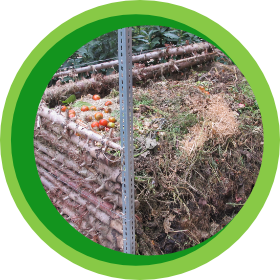How soil is formed

Nature knows no waste. With this experiment, the pupils learn about organic waste being valuable raw material and about basic principles of the circular economy. Plant residues provide food for soil organisms, which make a valuable contribution to living, nutrient-rich soil.
LEARNING GOALS

Pupils can
- name important factors and processes of soil formation
- carry out the composting exercise as instructed by the teacher and document it in a meaningful way
- evaluate the experiment and explain the process of composting
- name suitable organic waste for composting and visually determine the degree of maturity of a compost as well as compare compost and soil
- summarise the knowledge gained with regards to the initial question
Background Information
Subjects: Biology and Environmental Studies, Geography and Economics
Required Materials: Wooden box, fresh fruit and vegetable waste from the kitchen, crop residues, lawn clippings, green cuttings from the garden, wild herbs (“weeds”), some ripe compost, small shovel, a few equal sized buckets
Required premises/equipment of the rooms: school garden or school open space
Ideal for: small groups
Time required: approx. 1 teaching unit
Preparation
- Explore suitable locations on the school grounds where the wooden box can be placed for about four to five weeks and clarify this in advance with the school administration. The location should be semi-shaded and protected from the wind. Unsealed soil and warm, moist conditions encourage the activities of soil organisms.
- Clarify what suitable organic material from the garden or kitchen waste is available at school. Discuss with the pupils which organic material is suitable for the planned exercise. In addition, you can ask them to bring suitable organic material from their own kitchen or garden.
- To avoid the plant materials being too moist overall, lawn cuttings and “weeds” should be spread out on an area and dried in the sun beforehand.
TIP

Citrus fruits and banana peels should not be used, as they are often treated with plant protection products.
Tasks in class
- As an introduction, the following initial questions can be discussed together: We want to recycle plant waste and make good compost from it – how does composting “work”? How can we achieve good composting? What can we use the compost for? The pupils can guess or present any knowledge and experience they may already have.
- Discuss the choice of location with the pupils or jointly choose a suitable place on the school grounds for the wooden box in a semi-shaded, sheltered location. Ideally, the box is placed directly on a ground that is not sealed, so that soil organisms, e.g., earthworms can enter, which benefits the process.
- In the wooden box, the kitchen waste, harvest residues, green waste etc. are placed in thin layers. Between the thin layers with different vegetable wastes, mature compost is repeatedly inserted for “inoculation”. The pupils record and document the materials brought in and their quantities, e.g., in a simple table. The quantities can simply be recorded in terms of volume. For this purpose, the materials are put into buckets of the same size before they are put into the compost and the number of filled buckets is recorded.
- Furthermore, the pupils observe and record whether, or which, animals are already in the freshly created compost box.
- Once the wooden box has been filled, it remains at the chosen location for four to five weeks.
- After about four weeks, the pupils can examine the filling of the wooden box.
For this purpose, the pupils refer to their protocols from the beginning of the composting experiment and compare the materials present and the animal found.
Which materials have decomposed / which are still present?- Which materials have decomposed / which are still present?
- Which soil organisms are present, which ones are no longer present?
- The use of a microscope can be practised.
- Which soil animals could have been involved in the decomposition of the plant remains? Explain that the organic materials are decomposed by soil organisms. What do the soil organisms “like”?
- The pupils compare their (half-finished) compost with soil/substrate from the school grounds.
- Ask the initial questions again. The pupils summarise their findings. What can mature compost be used for? In addition, the concept of a natural circular economy can be discussed.
DID YOU KNOW?

How hot can it get in a compost heap or in a small composting box?
A compost heap can have a temperature of up to 70°C and even more.
